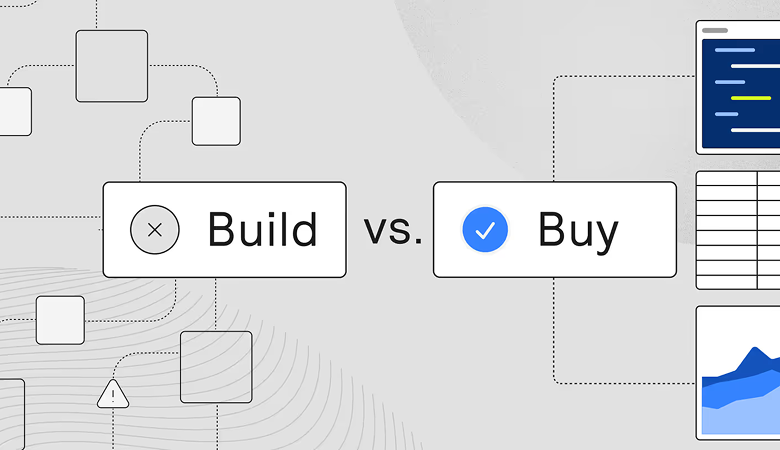Maxio pricing ranges from free to paid plans starting at $599 per month, plus custom-priced enterprise plans. The real cost for you in 2025 depends on billing volume, compliance needs, and whether you need advanced revenue recognition features.
Quick overview of Maxio pricing plans

Maxio offers three pricing tiers designed for SaaS teams at different growth stages. Whether you're testing billing flows or managing millions in revenue, there's a plan that fits. Below is a breakdown of each option, including what the plan costs, who it’s for, and what you get:
Note: The exact plan offerings can vary depending on what Maxio provides in your area. The Maxio cost structure is transparent at the entry level but scales based on volume and advanced needs.
What is Maxio best for?
Maxio is built to handle the financial operations of SaaS firms that care about compliance, recurring revenue, and reporting.
Maxio plan-by-plan pricing breakdown
Build (Free)
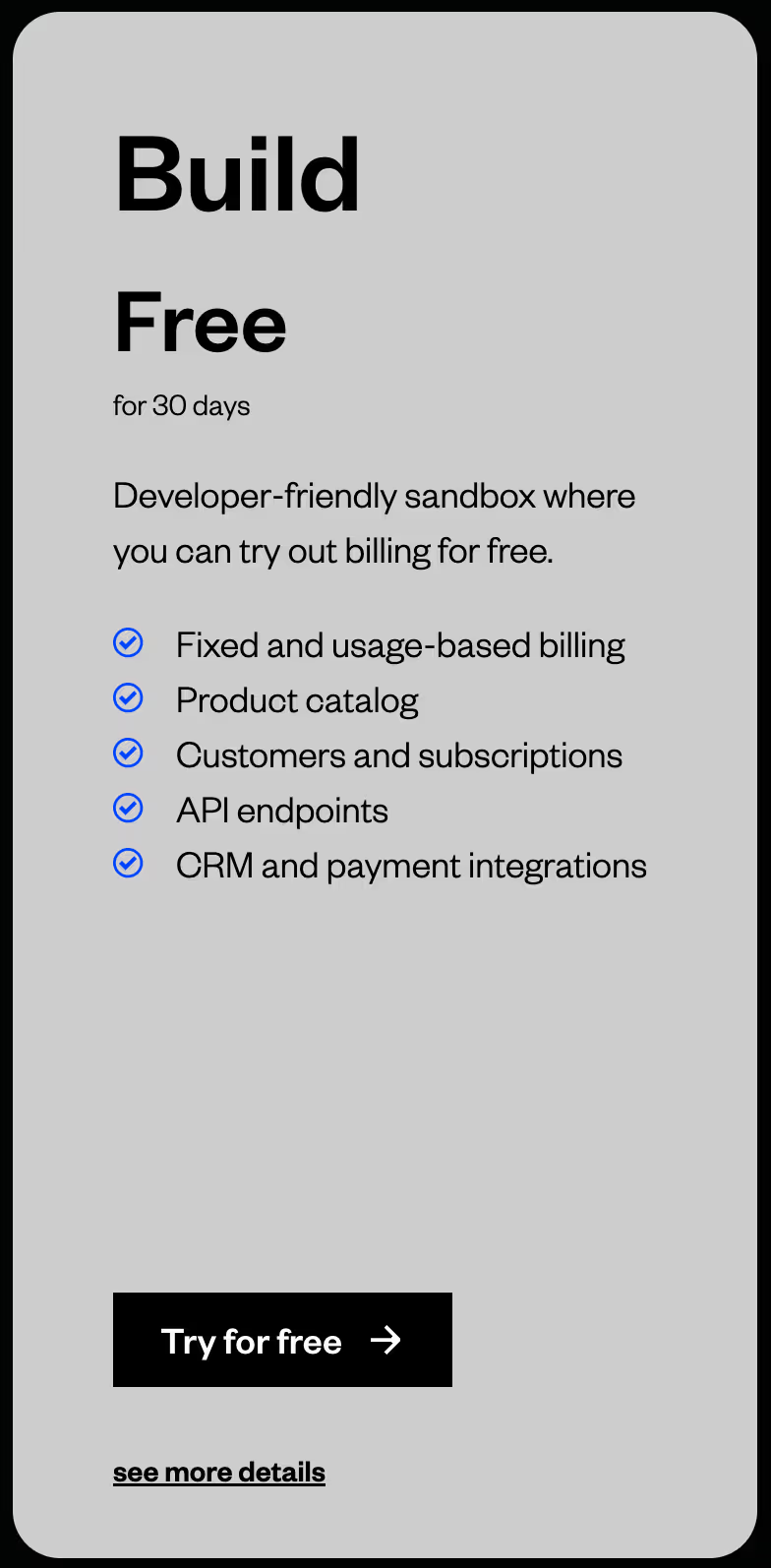
The Build plan is Maxio’s free, no-expiration tier. It’s designed for technical teams who want to test integrations and build out billing logic in a safe environment.
Key features:
- Full API and SDK access for testing Maxio billing workflows
- Dummy payment gateway support (simulate success/failure)
- Developer-first setup to validate hybrid and usage-based pricing
- No access to live billing or revenue recognition tools
Who is this plan best for?
This plan is ideal for devs or early-stage teams evaluating Maxio’s usage-based pricing software features. It’s a sandboxed space where you can explore Maxio subscription management and test workflows with real API calls, without triggering invoices or affecting your accounting setup
Note: The Build plan may show up as "Sandbox plan" or “free trial” depending on your region.
Grow ($599/month)
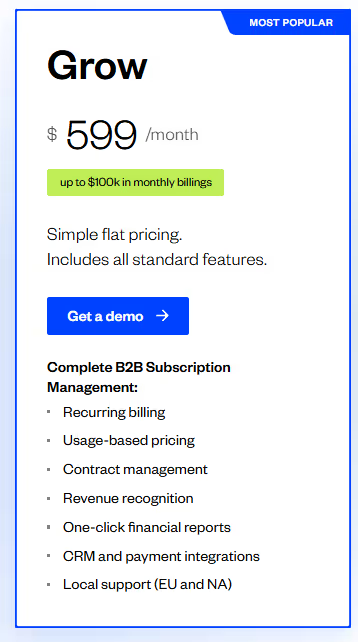
The Grow plan brings together core Maxio billing tools and real-time financial reporting. It also includes up to $100K/month in billings. It’s considered a solid fit for SaaS teams who are ready to automate operations.
Key features:
- Automated revenue recognition with ASC 606 / IFRS 15 compliance
- Built-in Maxio subscription management with contract and renewal controls
- SaaS metric dashboards (MRR, ARR, churn, cohorts, Subscription Momentum)
- Multi-currency billing (135+ currencies with auto FX updates)
- Maxio Payments gateway
- Native Maxio integrations for Salesforce, HubSpot, QuickBooks
Who is this plan best for?
This plan is made for SaaS businesses making between $50K—$500K in MRR that need to move beyond manual billing. Maxio revenue tools under this tier help deliver audit-ready reports, reduce close cycles, and give finance teams more confidence month over month.
Scale (custom pricing)
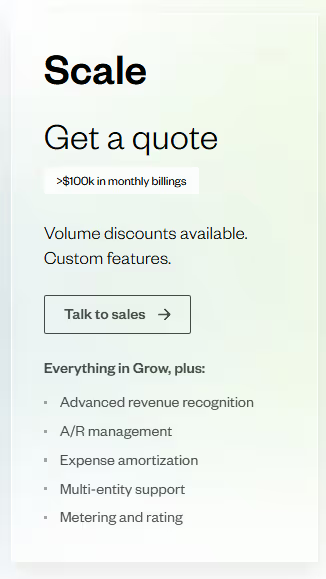
The Scale plan unlocks Maxio’s full feature set for large SaaS companies. It’s made for managing complex billing environments, multiple entities, and global compliance needs.
Key features:
- Everything in Grow
- Carveouts, SSPs, multi-book Maxio revenue support
- A/R aging reports, Days Sales Outstanding, and diagnostic payment insights
- Expense amortization and milestone billing workflows
- Multi-entity financial consolidation and forecasting
- AI-driven revenue and cash flow projections
- Premium SLA: 1-hour response, dedicated success manager
- Custom ERP Maxio integrations (e.g., NetSuite, custom connectors)
Who is this plan best for?
It’s built for public companies, enterprise SaaS, or finance-heavy teams with aggressive reporting needs. If you're answering to investors, managing subsidiaries, or forecasting revenue across currencies, Maxio pricing at this level is built to support your scale.
Which plan should you choose?
If you're in the early validation stage, start with Build. It gives full access to APIs and test data, making it the easiest way to evaluate Maxio subscription management and billing flows.
For SaaS companies with real revenue, Grow is the best choice. It covers all core Maxio billing needs, from recurring invoicing to Maxio revenue reports, without unpredictable costs. You’ll get access to the tools needed for compliance, forecasting, and monthly closes.
Teams with $500 K+ MRR or international reporting needs should look at Scale. It's for high-volume scenarios where granular tracking, multi-entity rollups, and AI forecasting drive financial clarity. If you’re serious about growth, this plan is worth it.
Maxio pricing compared to alternatives
Compared to Chargebee and Orb, Maxio pricing is geared more toward SaaS companies with finance teams and fixed revenue models. It includes built-in revenue recognition and audit-ready reporting, but the structure is more rigid, and configuration often requires support.
Chargebee offers a faster start and is more accessible to early-stage teams. It handles basic subscriptions smoothly but locks advanced features, like revenue recognition, usage billing, and multi-entity support, behind higher tiers.
Orb, by contrast, was built for companies evolving fast. It supports real-time billing, usage modeling, and flexible pricing logic right out of the gate. Instead of locking pricing into templates, Orb gives teams full control over how usage data flows into revenue, making it a strong choice for product-led and API-first businesses.
Competitor comparison table
Is Maxio’s pricing fair?
Maxio pricing is fair for SaaS companies that need built-in revenue recognition, audit-ready reporting, and support for complex billing workflows. If you're managing compliance requirements like ASC 606 and have predictable revenue, the pricing structure makes sense.
The $599/month Grow plan includes up to $100,000 in monthly billings, which is competitive for mid-market teams. Do keep in mind that going over $100K/month means you’ll have to upgrade to the Scale plan rather than incurring overage charges. Maxio software also requires more effort to implement. Custom reporting often depends on SQL.
Maxio.com offers strong value, but mostly for companies that prioritize financial control over speed. If your business is evolving rapidly or exploring usage-based pricing, other platforms can offer more flexibility per dollar.
FAQs
Can Maxio handle complex billing scenarios effectively?
Yes. Its Advanced Billing system supports various configurations, allowing businesses to tailor billing to their specific needs.
How does Maxio integrate with popular payment processing systems?
Maxio offers integrations with leading payment processors such as Stripe, PayPal through Maxio Payments.
Does Maxio have a subscription API?
Yes, Maxio provides a subscription API. It allows developers to create, manage, and customize subscriptions programmatically, facilitating integration with existing systems.
Why SaaS teams choose Orb over Maxio
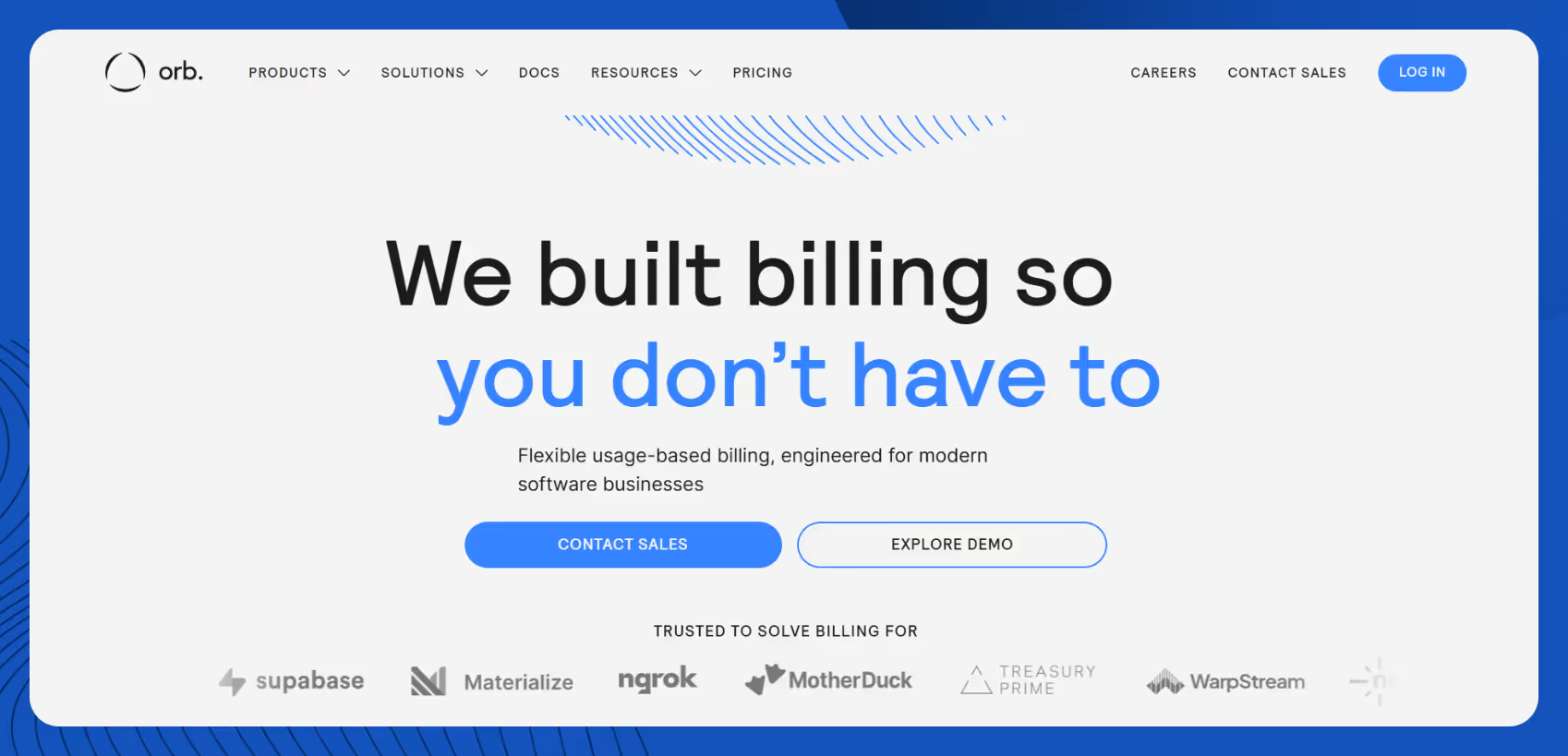
Maxio’s pricing is built for structure and control. For companies with stable billing models and audit-heavy workflows, it offers clear benefits.
However, if your team is evolving its monetization strategy, Maxio can feel rigid, slow to adapt, and expensive to scale.
Orb gives you a different path forward.
Orb is a done-for-you billing platform for SaaS and GenAI companies that want to treat billing as a strategic growth engine, not just an accounting tool. It connects your product usage data, pricing logic, and revenue workflows into one unified system.
That means you can test pricing, launch updates, and track revenue in real time, without waiting on engineering or rewriting your backend. Here’s how Orb helps teams adapt, iterate, and grow:
- Flexible pricing, no hardcoded logic: Support flat-rate, usage-based, hybrid, or tiered pricing without engineering bottlenecks. Orb lets you define value metrics with SQL and evolve pricing models as your product and go-to-market mature.
- Usage tracking built for precision: Every event is captured and processed through Orb RevGraph, giving finance, product, and engineering teams a shared source of truth. No dropped data. No reconciliation issues. No surprises on invoices.
- Product and pricing control in one place: Launch new SKUs, change pricing per region, or roll out experiments to specific segments, all from a unified interface. Pricing doesn’t have to be hardcoded anymore.
- Built-in tools for pricing experiments: With Orb Simulations, you can test new pricing models using real product usage data. Run scenarios in parallel, forecast revenue impact, and pick the model that performs best, before making any changes live.
- Unified billing, invoicing, and reporting: Finance teams get full transparency across billing, revenue attribution, discounts, and adjustments. Everything’s audit-ready, with native support for ASC 606 and clear documentation for every transaction.
- Developer-first foundation: Orb’s API-first architecture means integration is fast and flexible. Engineers stay in control of implementation, while business teams own pricing and revenue strategy without creating technical debt.
- Built to scale alongside your business: Whether you're billing on billions of usage events or introducing pricing changes every quarter, Orb is designed to handle high data volume, advanced logic, and enterprise-grade compliance from day one.
- A partner, not just a platform: Orb supports your rollout with dedicated implementation, migration, and ongoing guidance. As your pricing strategy evolves, our team is there to help you move faster, without compromising accuracy or reliability.
If you're hitting walls with rigid tools like Maxio software, or if you're looking for more control without more overhead, Orb gives you the flexibility to price with precision, bill with confidence, and scale on your terms.
Explore Orb’s pricing plans and find one that fits your needs.

%20(1).avif)

